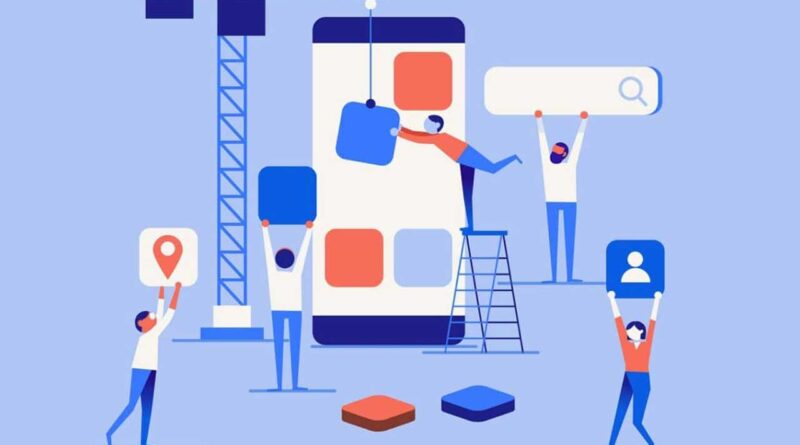How To Learn To Develop Mobile Applications From Scratch?
There are about 5 billion smartphone users around the world, and this number is constantly growing. Smartphones have become a part of our personal and professional lives, with people spending on average approximately 3 hours and 35 minutes a day using their mobile apps. On the other hand, they spend only 13 minutes on the Internet per day, meaning that the time they spend using applications is 16 times more than the time they spend browsing websites on their phones, from here the importance of learning to develop mobile applications.
Why learn to develop mobile applications?
The aforementioned facts have made companies aware of the importance of applications, and that they can be a channel for providing services and direct marketing to customers. That is why companies are rushing to design mobile applications to provide services to customers directly on the phones.
You should also know that learning to develop mobile applications is not easy, if it was easy for everyone to learn it and there would be a surplus of application developers. But at the same time, it is possible if you know how to start and from where. Many beginners do not know how to get started and cannot determine the skills and knowledge they need in order to become an app developer. To start developing mobile applications, you should be familiar with two types of applications:
Authentic applications
Authentic apps are apps that are intended to run exclusively on one platform, either Android or iOS. This means that you cannot develop an original application that works on Android and iOS at the same time, because the mobile application development techniques directed to Android are different from the mobile application development techniques directed to iOS. Android applications are developed using the programming language Java or Kotlin, while Apple applications are developed using the programming language Swift or objective-c.
Hybrid applications
Hybrid applications have appeared in recent years as a new technology for developing mobile applications, which are applications that work on both Android and iOS platforms, unlike the original applications. It is sufficient to create one copy of the application and it will work normally on both platforms without the need for modifications. What is more, hybrid applications are developed using regular web technologies, ie JavaScript, HTML and CSS, which are simple and easy to learn.
How to learn to develop mobile applications?
In this part, we will focus on developing hybrid applications, because learning their technologies is easier. Also, you will not have to do the same work twice, it is sufficient to create one application and it will work on both Android and Apple platforms, and this will save you a lot of time and effort. We will review the skills necessary to develop hybrid applications, the arrangement here is not mandatory, you can learn these skills in the order that suits you.
1. Basic web technologies
The basic web development and programming techniques consist of 3 programming languages: HTML, CSS and Javascript. These programming languages are essential for developing websites and web applications:
- HTML: Known as HTML, it is used to create website pages and insert content such as: images, text, paragraphs, lists, and tables.
- CSS: CSS is used to format the contents of website pages and web applications, through the ability to control page appearance, colors, fonts, and dimensions. And it enables you to design responsive sites with different devices, so that the design of the site changes to fit the size of the screen on which it is presented.
- JavaScript: You can build static, non-interactive web pages using HTML and CSS, but if you want to make your site interactive you will need to use JavaScript. It is a programming language that enables you to create interactive elements on the page, such as: interactive buttons and menus, and allows interaction with everything the user does on the page, such as: opening or closing a web page, moving the mouse or writing, and others.
Learning web technologies is not difficult, because they are simple and easy to learn. It is best to start with it. There are other technologies that fall under the category of web technologies, that can help you develop websites and web applications faster, such as jQuery, bootstrap, and others, but they are not necessary as they are utilities and complement to the three web technologies.
2. Mobile application frameworks
There are many frameworks that facilitate the development of mobile applications via web technologies, help you accomplish many routine tasks and take into account the applicable security standards. Among them, but not limited to:
- NativeScript is a free, open-source framework for building mobile apps that run on Android and iOS. It helps programmers to shorten development time by creating applications that resemble original applications in terms of look and functionality. This framework supports Angular, Vue.js, TypeScript, and Javascript.
- React: A JavaScript library developed by Facebook, it is used to build interactive user interfaces, especially in single-page applications (SPA). React works on the concept of components, creating user interfaces by installing off-the-shelf components.
- PhoneGap is an open-source framework for developing hybrid applications using web technologies. It allows easy access to phone hardware and features, such as camera and GPS. It also has a large library that facilitates the work of programmers.
- Cordova: Cordova is an open-source framework for developing mobile apps using regular web technologies. Cordova wraps your web application using HTML, CSS, and JavaScript and makes it appear like any other authentic mobile app. Cordova provides many add-ons and libraries that help developers with many tasks, and is characterized by speed, flexibility and works on all platforms.
3. User interface design
The good design of the application is one of the most important things that give the user a distinctive experience when using it. Whatever your application is useful, innovative and provides high-quality services, people will not accept it and your efforts will be wasted if its design is poor. There are two aspects of design that every application developer should learn, namely, the user interface (UI) and the user experience (UX). Both of these elements are important for a successful, easy-to-use app delivery:
- User Interface: The user interface determines the form and design of the application, how the user interacts with it, and everything related to the design such as: colors, fonts, images, menus, and others. The aim of the user interface is to create a beautiful application with an attractive and elegant design.
- User Experience: User Experience defines the impression an app makes on a user. The main goal of the user experience is to facilitate the use of the application and remove all obstacles that may make it difficult for the user to benefit from the application’s services.
4. Standards of security and protection
Mobile applications are different from regular websites or programs, so privacy in the field of mobile applications is much more important. This is because the mobile is a personal device that a person carries with him everywhere, and the mobile stores a lot of information and sensitive data that people do not usually want to disclose, such as: their messages, calls, pictures and videos.
Moreover, the smartphone contains devices that allow access to many data about the user, such as a camera or geolocation device. All these things make the protection, security and protection of the privacy and data of the application’s users very important.
For this reason, smart phone application stores, such as Google Play and App Store, are strict in this aspect, and applications that do not respect generally accepted security and protection standards are not accepted. If you want to be a professional in developing applications, you must learn everything related to user protection laws and privacy laws such as: GDPR, PDPA and others, and you must also respect the procedures and standards in force in this field.




